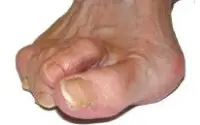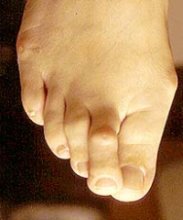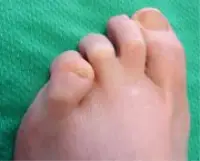overlapping toes
AUTHOR: Marc Mitnick DPM home --> overlapping toesWHAT ARE OVERLAPPING TOES
Overlapping toes is a condition that may be present at birth (congenital) or in most cases develops later on in life. The condition may affect the patient by being nothing more than unsightly and a slight inconvenience when selecting shoes, all the way up to very painful in most shoes.
Diabetics, those with poor circulation, and individuals with nerve impairment are at greater risk with this type of foot structure because of the friction and pressure points that are created with toes that do not line up straight.
In many instances overlapping and underlapping toes may be a result of a hammertoe deformity or a bunion deformity.

In severe bunion deformities, as the big toe moves toward the second toe, the big toe may either go under the second toe, usually forcing the second toe to become a hammertoe. Other times the big toe may deviate over the second toe, forcing the second toe into the ground as the patient walks, usually creating pain in the second toe. In either situation the second toe may become painful even though there is no pain in the bunion joint. From a strictly surgical standpoint, many times it is necessary to correct the non-painful bunion deformity along with the second toe in order to bring about relief. There are however, instances where only the second toe requires surgical correction and the bunion may be left alone. In these cases the bunion deformity is mild and only putting marginal pressure on the second toe.
As toes become more arthritic they start to change shape and in turn no longer line up properly. Compounding this is the formation of bone spurs that may be present on each toe. If two of these bone spurs happen to press against each other they create excessive pressure points which can lead to corns or even bursitis. In the case of a poorly controlled diabetic, or an individual with inadequate circulation or diminished neurological sensation, the excess pressure point can cause the tissue to break down, become infected, or ulcerated creating a serious medical problem.
Conditions such as rheumatoid arthritis can exacerbate this problem and grossly deform the appearance of the toes.
Some people have an inherited tendency to develop overlapping toes. The most commonly observed incidence is an overlapping fifth toe which bends over the fourth toe. This may occur on one or both feet. In most cases it is more annoying than anything else, however, there are cases where it can become a problem as a person ages. In women, the ability to wear a high style dress shoe may be hampered by the overlapping fifth toe. Because of the tightness of the space between the fourth and fifth toes, some people will develop chronic athletes foot, due to the dark constantly moist environment that is created between the two toes. When a congenital overlapping fifth toe becomes a problem that is not alleviated by shoe selection or padding, it may be surgically corrected.

As originally stated most cases of overlapping toes are more a cosmetic issue than painful problem.
TREATMENT OF OVERLAPPING TOES
conservative approach to overlapping toes
Non-surgical treatment includes proper shoe selection where the shoe has a wide and high toe box to allow for the toe deformity without putting too much pressure on any of the toes. For you women reading this article, remember, tight pantyhose will also contribute to this problem.
There is no shortage of padding sold in drug stores these days. As long as they are non-medicated you might have to experiment around with some of the different types of pads in an effort to find the best one for you. The reason you do not want to use a medicated pad is because these pads generally contain an acid compound which attempts to "eat" away at any corn that you may have. The problem is the acid does not know when to stop and I see people in the office with infections and small ulcers as a result of having used too much acid or having left the dressing on for too long. Again, this is particularly a problem in diabetics, those with poor circulation, and impaired neurological sensation.
surgical approaches to overlapping toes
There are two approaches to correcting the congenital overlapping fifth toe. One is to do a skin-plasty procedure where the tension on the skin just behind the fifth toe is released and redirected in an effort to allow the fifth toe to line up next to the fourth toe instead of overlapping. When the deviation of the fifth toe is too great, and it is deemed that a skin-plasty would not be sufficient to straighten the toe, then another option is to fuse the fifth toe to the fourth toe. This too is a soft tissue procedure where the fifth toe is sewn to the fourth toe. For many this is not an acceptable option because even though the fifth toe is now straight and not overlapping, the fourth and fifth toes are now connected as one.
I should also mention that back in the "old" days many surgeons would just amputate the fifth toe as a means to an end.
As far as surgical treatment goes for overlapping toes other than the congenital overlapping fifth toe, there are various approaches and procedures and each patient needs to be evaluated individually to determine how much surgery and what types of procedures will most benefit them.
Soft tissue procedures Some of the available procedures include soft tissue releases where the tendon on top or bottom of the toe is either cut or just lengthened in an effort to redirect the position of the toe. This may also include what is known as a capsulotomy where the ligament that attaches one bone to the next is partially incised, again in an effort to redirect the toe. In general, these procedures will not adequately re-position a toe and more work, particularly bone work, will need to be done.
Bone surgery includes arthroplasty where the actual joint between two bones is remodeled usually be removing a small piece of bone. (This the most common type of hammertoe surgery performed) A joint fusion many times is performed instead where the joint is fused. The toe is aligned in the position the surgeon desires, then fuses the joint, to keep the toe in a straight alignment. Although cosmetically the toe will look much better, what has been created is what is known as a "pencil toe" meaning the toe will not bend. In most cases this should not be an issue. What does become an issue is if the resulting straight toe (usually the second toe) is too long relative to the length of the other toes. In these cases it is very common for the patient to develop and corn at the end of the toe because the toe constantly butts up against the end of the shoe and because the toe does not bend, there is a lot of pressure created on the end of the toe and a corn forms.
Contrary to what you may read elsewhere, there are no exercises that will straighten your toes, however, in many cases the formation of overlapping toes, bunions and hammertoes are the result of an abnormality in one's gait. A proper evaluation by a podiatrist can determine if that is part of the problem. If so, with the proper use of an orthotic, the abnormal gait pattern can be corrected and thus remove the factors that are causing the toes to deviate. Obviously, the younger a person is when they are evaluated and the earlier treatment is instituted, and the better a person complies, the better the anticipated outcome.
REFERENCES
Wheeless' Textbook of Orthopaedics
Want more information? CLICK HERE


Recent Articles
-
Vitamin D impact on health
Feb 06, 23 07:17 PM
Researchers are suggesting that the effectiveness of Vitamin D in fighting and preventing disease is predicated on a persons body mass index (BMI). The thinner the person the greater the positive impa… -
Foods to speed up healing
Feb 01, 23 02:41 PM
One of the best ways to help yourself heal faster after surgery is to eat well. Getting the proper nutrition will provide your body with the essentials it needs to promote healing. Here is a suggestio… -
Cancer and Type 2 Diabetes
Jan 25, 23 04:52 PM
An article revealing that older type 2 diabetics have a higher incidence of cancer then non-diabetics. It is suggested that cancer may surpass CVD as the number one cause of death in older diabetics. -
Does glucosamine or MSM reduce arthritis pain?
Jan 22, 23 01:41 PM
A good review of the possible benefits to taking glucosamine, chondroitin or MSM for arthritis. Always beware of the possible side effects of over the counter supplements. -
shin splints
Jan 18, 23 05:12 PM
A great review on the various causes of shin splints, along with treatment options. -
Whats new in skin cancer?
Jan 15, 23 08:32 PM
A presentation of newer skin protection combinations in an effort to better protect the skin from the hazards of sun exposure. -
Causes and risk factors of warts
Jan 14, 23 05:02 PM
A good review of the causes of warts and protective measures you can take to prevent developing them. -
Do chronic wounds need to be dressed daily?
Jan 11, 23 02:18 PM
Because of supply chain shortages as well as staffing shortages particularly during the pandemic, many institutions extended the time between dressing changes for chronic wounds. Is this really the be… -
Food choices that raise your risk of type 2 diabetes
Jan 08, 23 10:07 AM
A good review of how blood sugars can become elevated and the harm that can do. Certain food groups have a tendency to raise your blood sugars and should be avoided. -
Outcome stats from Scarf bunionectomy
Jan 03, 23 03:04 PM
The Journal of Foot and Ankle Surgery recently reported a meta analysis of outcomes in 1583 Scarf bunionectomies that met their inclusion criteria. Adverse events did not seem to be any better or wors…